Create
Vintage St. Pete: The Don CeSar (Part I)
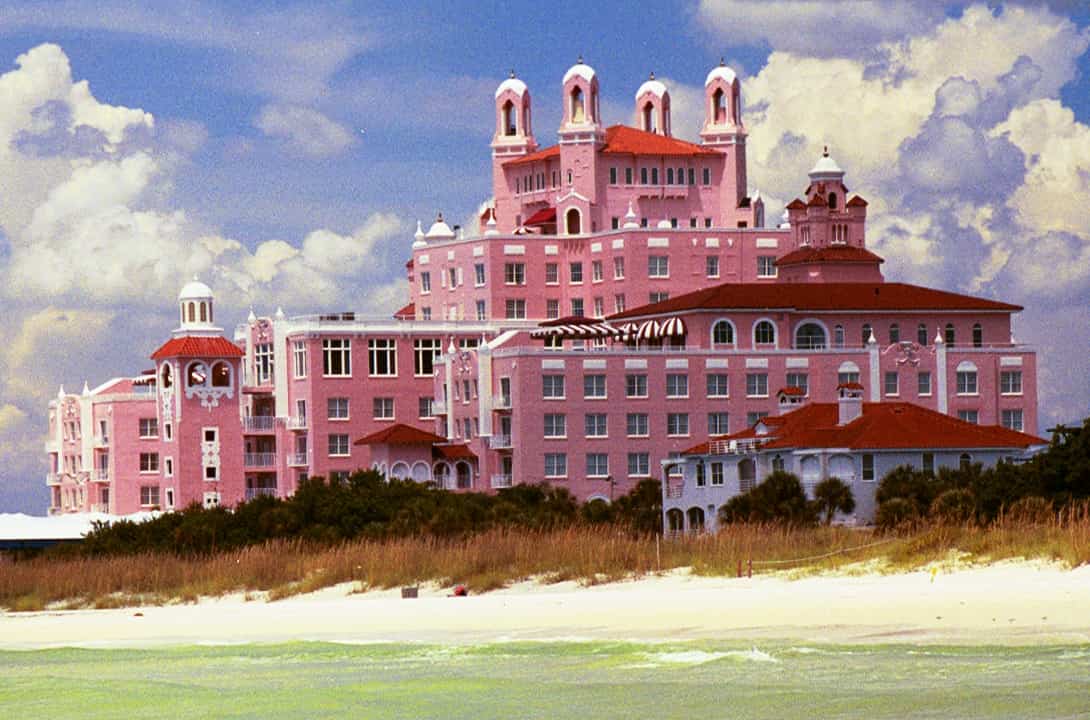
Sometimes it seems as if the Don CeSar Hotel, the great pink castle that separates St. Pete Beach from Pass-a-Grille, has always been there. Like the St. Pete Pier and the Sunshine Skyway Bridge, the Don is both iconic and unmissable, a landscape feature so distinctive that even longtime residents can scarcely remember a time without it.
The Don was a product of the 1920s Florida land boom, and a victim of the Great Depression that followed. And for 25 years, it served the American military in various capacities.
It was a landmark, then it was an eyesore, then a landmark again.
Today’s splashy Don CeSar Resort, with the restored opulence of the hotel’s 1920s heyday, is No. 5 on the Southern Living ranking of “Best Florida Beach Hotels.”
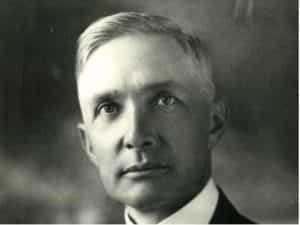
Thomas J. Rowe
That’s an appraisal that would surely please Thomas J. Rowe, the real estate speculator and builder who purchased 80 acres on Long Key, as the barrier island is technically known, in the early 1920s. Rowe, who’d moved to the area from Norfolk, Virginia in 1919, paid developer Perry Snell $100,000 for the mostly-beachfront property.
Rowe divided his land into lots, creating a subdivision for single-family homes, a park, a miniature golf course and beach access, with the choicest spot – a half mile on the surf itself – set aside for a luxury hotel. Indianapolis architect Henry Dupont drew up the plans, according to Rowe’s specifications.
The hotel design was a hodge-podge of Mediterranean and Moorish styles, inspired by everything from Miami’s Villa Vizcaya to the Royal Hawaiian Hotel in Honolulu.
Like that landmark beach hostelry, Rowe’s T-shaped palace was painted a light coral pink. Historians believe Rowe was also influenced by the cottages he remembered from his impressionable youth, as a visitor to Ireland, made of rosy lime mixed with mortar. Rowe referred to his hotel’s color as “rouge.”
The walls were made of concrete mixed with gravel and beach sand, reinforced with steel rods, capped with tensile-strength tile and then stucco. Spanish red tile and minarets garnished the roof. After a disagreement with Rowe, architect Dupont was fired, and work continued under Rowe and contractor Carlton Beard, the sketches sometimes changing daily. A sweeping grand staircase was added, as was an ornate Moorish-style tower to disguise the Don’s unattractive but necessary in-house water tower. Rowe also insisted on constructing a fountain in the center of the lobby.
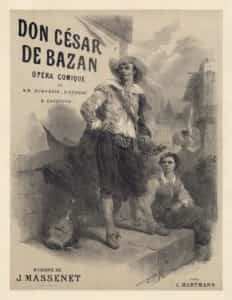
Before “Maritana,” the character of Don Ce-Sar appeared in “Don César de Bazan” by French composer Jules Massenet.
The name had been chosen long before the first concrete footers were poured. Rowe was particularly fond of Irish composer William Vincent Wallace’s opera Maritana, whose leading character was a rapscallion called Don César de Bazan.
The Don Ce-Sar Hotel opened, to much fanfare, on Jan. 16, 1928 – in time for the winter visitor season. The just-completed Boca Ciega Causeway, replacing an earlier, hand-cranked bridge, led motorcars to the front door, where a stone plaque read: “Come all ye who seek health and rest, for here they are abundant.”
A staff of 200 served hotel guests and whatever well-heeled locals could afford the night out. Cost for dinner and dancing was $2.50 per person.
As the local paper breathlessly reported:
St. Petersburg spread the light and gaiety of midwinter appeal to the far western limit of her pines and palms on the beaches of the Gulf of Mexico, and the gulf (sic) took on a new illumination, a music to rhyme with the endless roll of the surf and 1,500 dancing feet to set new echoes in the southern skies when the $1,500,000 Don Ce-Sar Hotel on Long Key opened the first page of its history in the brilliant scenes of Monday night.
St. Petersburg Times/Jan. 17, 1928
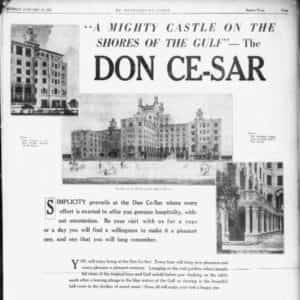 Tourists, in those days, were generally wealthy northerners who could afford to take the train to Florida in order to bask for weeks in the nourishing sun, bathe in the Gulf waters, play a spot of golf or tennis and enjoy the luxuries that came part and parcel with Thomas J. Rowe’s 10-story, 312-room sand castle.
Tourists, in those days, were generally wealthy northerners who could afford to take the train to Florida in order to bask for weeks in the nourishing sun, bathe in the Gulf waters, play a spot of golf or tennis and enjoy the luxuries that came part and parcel with Thomas J. Rowe’s 10-story, 312-room sand castle.
The “season” was January through April, although the Don Ce-Sar would accommodate guests as early as December, and as late as June.
Indeed, the guest roster in those early years included captains of industry, department store moguls and oil barons, with their families in tow. F. Scott and Zelda Fitzgerald enjoyed a week at the Don in 1930. Famed attorney Clarence Darrow was a guest. Rumors persist to this day that Al Capone – who was known to have business interests in St. Petersburg – loved the hotel.
At the center of it all was Thomas J. Rowe, always dapper and well-dressed, seeing to each and every detail. Rowe, who suffered from asthma and had a weak heart, smoked tiny cigars but did not drink (in fact, alcohol was only available at the first-floor bar and not in the grand dining room, on the fifth floor).
 He was estranged from his wife, former Norfolk Symphony violinist Mary Lucille Rowe, who remained in the couple’s downtown home and rarely, if ever, visited the hotel. Rowe lived in several rooms on the Don Ce-Sar’s first floor.
He was estranged from his wife, former Norfolk Symphony violinist Mary Lucille Rowe, who remained in the couple’s downtown home and rarely, if ever, visited the hotel. Rowe lived in several rooms on the Don Ce-Sar’s first floor.
“It seems that he was more passionate about the hotel than he was about the relationship with his wife, that’s for sure,” says Todd Gehrke, director of marketing for the Don CeSar Resort, and the on-site historian. “But who’s to say, really?”
According to Gehrke, business began to fall off almost immediately. “After the stock market crash in ’29, he actually told his employees ‘I’m not sure that we’re going to re-open … and quite honestly, I don’t know that I can pay you.’ His employees lived and worked on property, and they really had a passion for him just as a hotelier and a boss and a leader. He really cared for his team.
“One year, he finished the season with $18 after he paid everybody out. He definitely gave everything he had to make it work. He did actually pay his people, but walked away with very little at those times.”
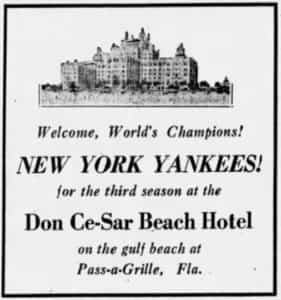 A deal struck with New York Yankees owner Col. Jacob Ruppert in 1931 staved off the inevitable. The team, in town each year for spring training, would bunk at Rowe’s hotel. Along with player families, Yankees staff and visiting media, Rowe was able to book 125 rooms, at $8 per room double occupancy with meals, for the years 1931 to ’33.
A deal struck with New York Yankees owner Col. Jacob Ruppert in 1931 staved off the inevitable. The team, in town each year for spring training, would bunk at Rowe’s hotel. Along with player families, Yankees staff and visiting media, Rowe was able to book 125 rooms, at $8 per room double occupancy with meals, for the years 1931 to ’33.
Included in the arrangement: A promise to provide steak for the ballplayers’ breakfasts, and all the fresh milk they could drink.
“Had it not been for the deal he made with the Yankees owner,” says Gehrke, “I don’t know that he would have been able to re-open.”
Just as the U.S. economy was showing signs of renewed life, and Rowe was paying off the debts he’d accumulated during the hotel’s lean years, World War II broke out in Europe, and Americans began to get very nervous.
On May 2, 1940, Thomas J. Rowe suffered a heart attack in the Don Ce-Sar’s expansive lobby, and died in his room three days later. He was 67.
After several rounds of “Who’s got the will?” in St. Petersburg courts, it was determined that Rowe had not signed the revised document he’d prepared; he had intended to leave the Don Ce-Sar to his beloved staff.
Which meant the hotel, and the parcels of surrounding property he still owned, were in Mary Lucille’s hands.
The Widow Rowe made a valiant, if somewhat half-hearted, attempt at keeping the Don open. But her lack of knowledge or experience in hospitality and hotel management, coupled with the arrival of a new and generally unlikable hotel manager from New Jersey, led to staff defections and guest cancellations.
American’s entry into the war, in December, 1941, was the death knell. Waiters, cooks and bellboys enlisted; the rich northern swells simply stopped booking.
“It was a long, lean winter,” June Hurley Young would write years later in The Don CeSar Story, “with rumors that enemy subs were lurking offshore.”
Award of an approximately $200,000 contract to R.E. Carson, Inc., local contractor, for the conversion of the Don Ce-Sar Hotel into an Army Air Forces hospital was announced by the War Department in Washington yesterday. Army Air Forces troops attached to the local basic training center have been occupying the big beach hostelry, near Pass-a-Grille, since the center was established here several months ago.
St. Petersburg Times/Oct. 4, 1942
Click here for PART II
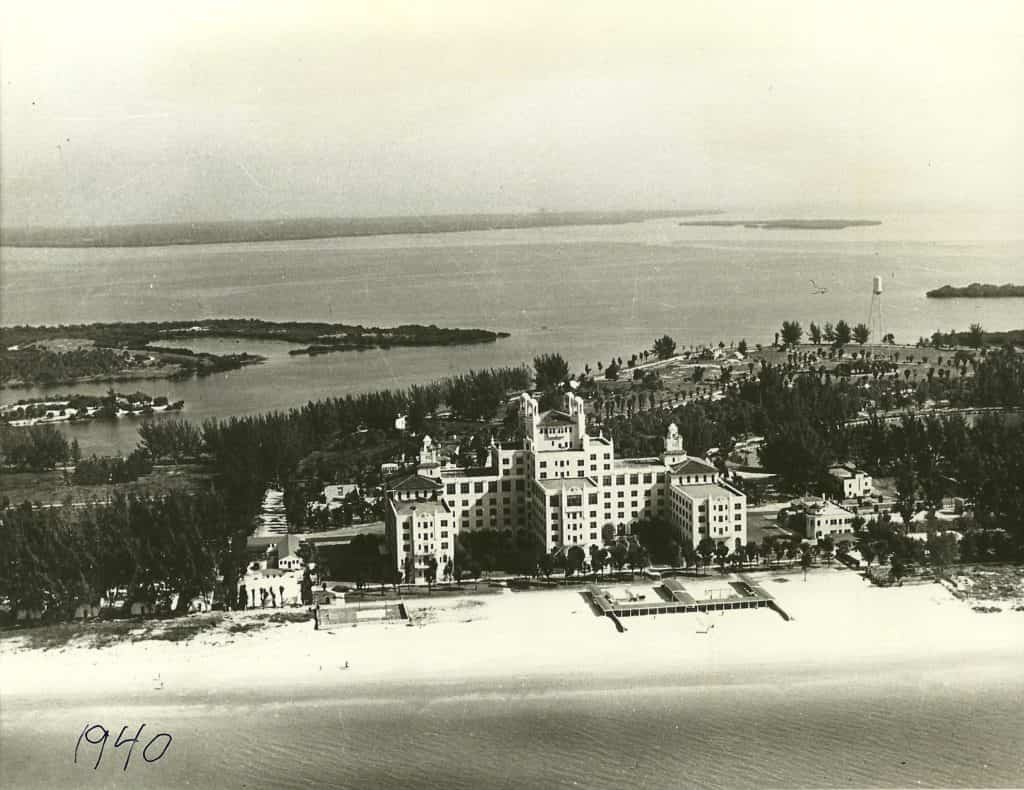








Nancy Ballen
July 23, 2023at1:40 pm
I spent 20 years coming to St. Pete and my grandmother
Lived on the inter- coastal facing the Don. I have been back tom
See the property but not return to
The Don. Love the architecture .
James Westfall
December 10, 2020at11:15 am
We saw your beautiful hotel on our way to Pass-a-grill last Sunday. We waited for the motorcycle parade which we taped for about a minute.
Cathy Harrelson
November 23, 2020at6:06 am
Wonderful article. I came to Florida in the late 1970’s and worked at the Don CeSar for 3 years – lifeguard, catering, and beach bar bartender. What a blast! We knew every nook & cranny, and sometimes had dealings with the ghost of the 5th floor. I’ll never forget the place, the people and the fun that only a 20-something can have. Beautiful. Thanks!
Minedga Archilla-McNamee
November 22, 2020at11:29 am
As a newcomer, Im happy it’s still there! Love architectural preservation!!
Shelly Perez
November 22, 2020at9:17 am
I grew up in Florida. As a child remember taking the bus to the beach with our family. Loved the big sand castle. As an adult after moving back to Florida worked as a pastry chef. Baking bread mostly. The other to men Greg and Billy were the real ones. It was fun. Learnjng the history. Also what floors were used for what during the war. Was glad it became the pink castle again. It would not be the beach without it! Have never been lucky enough to stay there though. Its beautiful. I know it took alot of paint to repaint it that year!
Paolina Kennedy
November 22, 2020at5:28 am
I enjoyed reading your article. I was married there in July 1996 outside. A beautiful indoor private brunch on the top floor. I hope we can stay there next year on our 25th wedding anniversary.
Look forward to part 2
Roger P. Schulman
November 22, 2020at2:08 am
Glorious article. Well done
Mary Ann Latimer
November 21, 2020at10:42 pm
Thanks for this wonderful look into history! It was nice to read about an employer caring about his staff, which, unfortunately, does not seem to occur much anymore. Fun reading about the hotel’s history.
Carrie
November 21, 2020at10:39 pm
As a young child I was always impressed with the Don Cesar. I grew up in Florida in the 70s. To this day I always dreamed of staying there one day.